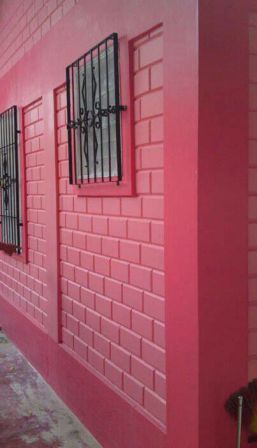For some time now, house construction in Uganda has relied on fired bricks that have made primary component of permanent building walls across.
However,they have come at a high cost to the environment. Although it is not clear how many trees have to be felled to produce at least 10,000 bricks for house construction in Uganda, what is clear are the devastating effects it has had on the hard wood cover in Uganda and Africa in general. Since the hard wood required to fire these bricks are increasingly becoming rare, the industry is adopting other alternatives.
Concrete blocks are a mixture of sand, gravel, cement and water molded to create a rectangular solid block. The block which is available in different sizes typically comes in a smooth finish but can be found in decorative split finishes that many people find more attractive. The concrete blocks that have a high demand in huge construction projects come in either solid or hollow blocks which are used on different components of a house.
Nassolo Racheal the Business Development Manager of East Africa Roofing system Ltd the parent company of Kadeco Concrete Ltd in Uganda explains that a Solid block is recommended for the wall fence and outside wall of the house while the hollow one is recommend for the room partitions and upper floors because they are lighter. Nassolo says that concrete is the most durable material on earth and that a house built with concrete blocks form a stronger wall that can last to over 100years. She says that 1 concrete block is equivalent to 4 fired bricks which reduces on the time used to lay a wall.
Haruna Katerega, a builder who has been at it for the last 15 years says that the challenge with these concrete blocks is that they are very expensive compared to other alternatives. To minimize these costs and yet enjoy the benefits of concrete blocks, some builders have resorted to making their own blocks on site although Nassolo says theses do not have the same comprehensive strength like those which are factory made.
Eng Dr Mose Kiiza Musaazi a senior lecturer at Makerere University, Faculty of Technology and Managing Director Technology for Tomorrow Ltd says that concrete blocks are very unsustainable. He says sand which makes 80% of the concrete block is increasingly getting extinct and leaves huge pits in the areas it is collected. On top of this the professor says that the compressive strength of sand blocks is low and cannot withstand pressure. He says if you drop a concrete block, it completely disintegrates.
Stabilized Soil Blocks
Stabilized soil blocks are strong economical blocks made from a mixture of sub soil and a small amount of cement compressed to form a block. Makiga appropriate technology Ltd, the patented manufacturer of the soil press Machine in Uganda has 4 types of soil press machines including Standard straight interlocking soil block press, Wide straight interlocking soil block Press, Curved interlocking soil block press and Standard Non-interlocking soil block press.
Nicholas Mbugua the Manager Makiga Appropriate Technology Ltd says that this technology utilizes the abundantly available sub soil across the country on construction sites from dug up foundations and septic tanks to make blocks. Because the blocks are made on site, there are no transportation costs and damage normally caused during transportation.
The blocks which interlock can be used to build walls, water and septic tanks among others without necessarily using mortar (Cement, sand and Water Mixture) between each block. This he says significantly saves up to 40-50 % of the building costs. After a year of operation in Uganda, Mbugua says his company has sold over 150 machines to organizations and individuals that are constructing schools, water tanks and low cost houses in northern Uganda.
Paul Kimera a civil engineer and one of the directors of technology for tomorrow says the idea behind this technology is to minimize the use of sand and cement in construction. Kimera says that the stabilized soil block has been tested in the labs of Makerere University and found to be water resistant, environmentally friendly and sustainable. This block he says can be used to build any type of building.
Eng Dr Musaazi says that the stabilized soil blocks are an incredible breakthrough in efforts to achieve affordable house construction in Uganda. Dr Musaazi says that since 95% of what is used is the abundant soil available on building sites, trees are saved and cement costs are minimized. Apparently 1 bag of cement can make up to 130 -150 stabilized soil blocks compared to 25 concrete blocks.
Haruna Katerega says he prefers the soil blocks to Concrete blocks since they are interlocking and therefore do not need mortar in between the blocks. He says that these blocks come with a smooth finish and does not require plastering.


I think the writter is right our forests are getting over & over each & every day due to use of burnt bricks so lets resort to sustainable soil blocks to preserve the vegetation
Waterproofing really essential to avoid moisture-related issues. It assured that the home is safe from moisture and water damage. Thanks for the lovely content.
Perfectly voiced
I would go for blocks coz I look upto durability. My great grandfather ‘s house was built with blocks 100+ years back but its still very strong
you are very right on that if you are not minding the cost and focusing on durability. however i would like to see the lab reports for the stabilized soil blocks to make a final comparison.
Barney23-this is an opinion. The writer is not a native English speaker. We should give him the benefit of the doubt.
CMU are much stronger if constructed with the right proportion of sand, cement, water and gravel, in addition to using the adequate rebar ties and filling the cavities with mortar as needed. It’s a much better method than the mud bricks